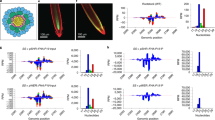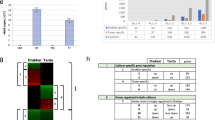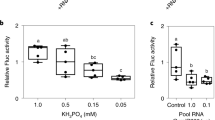Abstract
In RNA interference (RNAi), double-stranded RNA (dsRNA) is processed into short interfering RNA (siRNA) to mediate sequence-specific gene knockdown. The genetics of plant RNAi is not understood, nor are the bases for its spreading between cells. Here, we unravel the requirements for biogenesis and action of siRNAs directing RNAi in Arabidopsis thaliana and show how alternative routes redundantly mediate this process under extreme dsRNA dosages. We found that SMD1 and SMD2, required for intercellular but not intracellular RNAi, are allelic to RDR2 and NRPD1a, respectively, previously implicated in siRNA-directed heterochromatin formation through the action of DCL3 and AGO4. However, neither DCL3 nor AGO4 is required for non–cell autonomous RNAi, uncovering a new pathway for RNAi spreading or detection in recipient cells. Finally, we show that the genetics of RNAi is distinct from that of antiviral silencing and propose that this experimental silencing pathway has a direct endogenous plant counterpart.
This is a preview of subscription content, access via your institution
Access options
Subscribe to this journal
Receive 12 print issues and online access
$209.00 per year
only $17.42 per issue
Buy this article
- Purchase on Springer Link
- Instant access to full article PDF
Prices may be subject to local taxes which are calculated during checkout






Similar content being viewed by others
References
Baulcombe, D. RNA silencing in plants. Nature 431, 356–363 (2004).
Liu, J. et al. Argonaute2 is the catalytic engine of mammalian RNAi. Science 305, 1437–1441 (2004).
Qi, Y., Denli, A.M. & Hannon, G.J. Biochemical specialization within Arabidopsis RNA silencing pathways. Mol. Cell 19, 421–428 (2005).
Baumberger, N. & Baulcombe, D.C. Arabidopsis ARGONAUTE1 is an RNA Slicer that selectively recruits microRNAs and short interfering RNAs. Proc. Natl. Acad. Sci. USA 102, 11928–11933 (2005).
Brodersen, P. & Voinnet, O. The diversity of RNA silencing pathways in plants. Trends Genet. 22, 268–280 (2006).
Hiraguri, A. et al. Specific interactions between Dicer-like proteins and HYL1/DRB-family dsRNA-binding proteins in Arabidopsis thaliana. Plant Mol. Biol. 57, 173–188 (2005).
Yu, B. et al. Methylation as a crucial step in plant microRNA biogenesis. Science 307, 932–935 (2005).
Mallory, A.C. & Vaucheret, H. Functions of microRNAs and related small RNAs in plants. Nat. Genet. 38 Suppl, S31–S36 (2006).
Matzke, M.A. & Birchler, J.A. RNAi-mediated pathways in the nucleus. Nat. Rev. Genet. 6, 24–35 (2005).
Chan, S.W., Henderson, I.R. & Jacobsen, S.E. Gardening the genome: DNA methylation in Arabidopsis thaliana. Nat. Rev. Genet. 6, 351–360 (2005).
Zheng, X., Zhu, J., Kapoor, A. & Zhu, J.K. Role of Arabidopsis AGO6 in siRNA accumulation, DNA methylation and transcriptional gene silencing. EMBO J. 26, 1691–1701 (2007).
Yoshikawa, M., Peragine, A., Park, M.Y. & Poethig, R.S. A pathway for the biogenesis of trans-acting siRNAs in Arabidopsis. Genes Dev. 19, 2164–2175 (2005).
Allen, E., Xie, Z., Gustafson, A.M. & Carrington, J.C. microRNA-directed phasing during trans-acting siRNA biogenesis in plants. Cell 121, 207–221 (2005).
Vazquez, F. et al. Endogenous trans-acting siRNAs regulate the accumulation of Arabidopsis mRNAs. Mol. Cell 16, 69–79 (2004).
Xie, Z., Allen, E., Wilken, A. & Carrington, J.C. DICER-LIKE 4 functions in trans-acting small interfering RNA biogenesis and vegetative phase change in Arabidopsis thaliana. Proc. Natl. Acad. Sci. USA 102, 12984–12989 (2005).
Borsani, G. et al. Characterization of a murine gene expressed from the inactive X chromosome. Nature 351, 325–329 (1991).
Voinnet, O. Induction and suppression of RNA silencing: insights from viral infections. Nat. Rev. Genet. 6, 206–220 (2005).
Dunoyer, P., Himber, C. & Voinnet, O. Induction, suppression and requirement of RNA silencing pathways in virulent Agrobacterium tumefaciens infections. Nat. Genet. 38, 258–263 (2006).
Xie, Z. et al. Genetic and functional diversification of small RNA pathways in plants. PLoS Biol. 2, E104 (2004).
Zaratiegui, M., Irvine, D.V. & Martienssen, R.A. Noncoding RNAs and gene silencing. Cell 128, 763–776 (2007).
Fire, A. et al. Potent and specific genetic interference by double-stranded RNA in Caenorhabditis elegans. Nature 391, 806–811 (1998).
Fusaro, A.F. et al. RNA interference-inducing hairpin RNAs in plants act through the viral defence pathway. EMBO Rep. 7, 1168–1175 (2006).
Himber, C., Dunoyer, P., Moissiard, G., Ritzenthaler, C. & Voinnet, O. Transitivity-dependent and -independent cell-to-cell movement of RNA silencing. EMBO J. 22, 4523–4533 (2003).
Bouche, N., Lauressergues, D., Gasciolli, V. & Vaucheret, H. An antagonistic function for Arabidopsis DCL2 in development and a new function for DCL4 in generating viral siRNAs. EMBO J. 25, 3347–3356 (2006).
Deleris, A. et al. Hierarchical action and inhibition of plant Dicer-like proteins in antiviral defense. Science 313, 68–71 (2006).
Blevins, T. et al. Four plant Dicers mediate viral small RNA biogenesis and DNA virus induced silencing. Nucleic Acids Res. 34, 6233–6246 (2006).
Dunoyer, P., Himber, C. & Voinnet, O. DICER-LIKE 4 is required for RNA interference and produces the 21-nucleotide small interfering RNA component of the plant cell-to-cell silencing signal. Nat. Genet. 37, 1356–1360 (2005).
Herr, A.J., Jensen, M.B., Dalmay, T. & Baulcombe, D.C. RNA polymerase IV directs silencing of endogenous DNA. Science 308, 118–120 (2005).
Pontier, D. et al. Reinforcement of silencing at transposons and highly repeated sequences requires the concerted action of two distinct RNA polymerases IV in Arabidopsis. Genes Dev. 19, 2030–2040 (2005).
Kanno, T. et al. Atypical RNA polymerase subunits required for RNA-directed DNA methylation. Nat. Genet. 37, 761–765 (2005).
Onodera, Y. et al. Plant nuclear RNA polymerase IV mediates siRNA and DNA methylation-dependent heterochromatin formation. Cell 120, 613–622 (2005).
Kavi, H.H., Fernandez, H.R., Xie, W. & Birchler, J.A. RNA silencing in Drosophila. FEBS Lett. 579, 5940–5949 (2005).
Lukowitz, W., Gillmor, C.S. & Scheible, W.R. Positional cloning in Arabidopsis. Why it feels good to have a genome initiative working for you. Plant Physiol. 123, 795–805 (2000).
Wassenegger, M. & Krczal, G. Nomenclature and functions of RNA-directed RNA polymerases. Trends Plant Sci. 11, 142–151 (2006).
Zilberman, D., Cao, X. & Jacobsen, S.E. ARGONAUTE4 control of locus-specific siRNA accumulation and DNA and histone methylation. Science 299, 716–719 (2003).
Adenot, X. et al. DRB4-dependent TAS3 trans-acting siRNAs control leaf morphology through AGO7. Curr. Biol. 16, 927–932 (2006).
Moissiard, G. & Voinnet, O. RNA silencing of host transcripts by cauliflower mosaic virus requires coordinated action of the four Arabidopsis Dicer-like proteins. Proc. Natl. Acad. Sci. USA 103, 19593–19598 (2006).
Kurihara, Y. & Watanabe, Y. Arabidopsis micro-RNA biogenesis through Dicer-like 1 protein functions. Proc. Natl. Acad. Sci. USA 101, 12753–12758 (2004).
Lee, Y. et al. The nuclear RNase III Drosha initiates microRNA processing. Nature 425, 415–419 (2003).
Wu, F. et al. The N-terminal double-stranded RNA binding domains of Arabidopsis HYPONASTIC LEAVES1 are sufficient for pre-microRNA processing. Plant Cell 19, 914–925 (2007).
Kurihara, Y., Takashi, Y. & Watanabe, Y. The interaction between DCL1 and HYL1 is important for efficient and precise processing of pri-miRNA in plant microRNA biogenesis. RNA 12, 206–212 (2006).
Beclin, C., Boutet, S., Waterhouse, P. & Vaucheret, H. A branched pathway for transgene-induced RNA silencing in plants. Curr. Biol. 12, 684–688 (2002).
Finnegan, E.J., Margis, R. & Waterhouse, P.M. Posttranscriptional gene silencing is not compromised in the Arabidopsis CARPEL FACTORY (DICER-LIKE1) mutant, a homolog of Dicer-1 from Drosophila. Curr. Biol. 13, 236–240 (2003).
Li, J., Yang, Z., Yu, B., Liu, J. & Chen, X. Methylation protects miRNAs and siRNAs from a 3′-end uridylation activity in Arabidopsis. Curr. Biol. 15, 1501–1507 (2005).
Dalmay, T., Hamilton, A.J., Mueller, E. & Baulcombe, D.C. Potato Virus X amplicons in Arabidopsis mediate genetic and epigenetic gene silencing. Plant Cell 12, 369–379 (2000).
Zhang, X. et al. Cucumber mosaic virus-encoded 2b suppressor inhibits Arabidopsis Argonaute1 cleavage activity to counter plant defense. Genes Dev. 20, 3255–3268 (2006).
Havelda, Z., Hornyik, C., Crescenzi, A. & Burgyan, J. In situ characterization of Cymbidium Ringspot Tombusvirus infection-induced posttranscriptional gene silencing in Nicotiana benthamiana. J. Virol. 77, 6082–6086 (2003).
Henderson, I.R. et al. Dissecting Arabidopsis thaliana DICER function in small RNA processing, gene silencing and DNA methylation patterning. Nat. Genet. 38, 721–725 (2006).
Kasschau, K.D. et al. Genome-wide profiling and analysis of Arabidopsis siRNAs. PLoS Biol. 5, e57 (2007).
Bechtold, N. & Pelletier, G. In planta Agrobacterium-mediated transformation of adult Arabidopsis thaliana plants by vacuum infiltration. Methods Mol. Biol. 82, 259–266 (1998).
Acknowledgements
The SUC-GFP line was a gift of N. Sauer (University of Erlangen). TRV-PDS was provided by S. Macfarlane (Scottish Research Crop Institute). Antiserum to GFP was a gift of D. Gilmer (Institut de Biologie Moléculaire des Plantes-Centre National de la Recherche Scientifique). We thank members of the Voinnet laboratory for critical reading of the manuscript and R. Wagner's team for plant care. This work was supported by the European Molecular Biology Organization Young Investigator Grant to O.V. and by a Marie Curie Intra-European Fellowship (number 041419) to V.R-F.
Author information
Authors and Affiliations
Contributions
O.V. and P.D. designed this study; P.D., C.H. and V.R.F. performed the experiments; M.A. carried out DNA sequencing and O.V. and P.D. wrote the paper.
Corresponding author
Ethics declarations
Competing interests
The authors declare no competing financial interests.
Supplementary information
Supplementary Fig. 1
Splicing defects in the dcl4-9 allele. (PDF 146 kb)
Supplementary Fig. 2
The effects of dcl2-dcl3 and dcl1-dcl2-dcl3-dcl4 combination mutations on SUL silencing. (PDF 270 kb)
Supplementary Fig. 3
Accumulation of the hairpin section of the SUL transgene in triple and quadruple dcl mutant backgrounds (PDF 210 kb)
Supplementary Fig. 4
Side-by-side comparison of siRNA levels produced during RNAi of a GFP transgene in Arabidopsis, as triggered by the depicted GF-FG IR construct, driven either by the strong 35S promoter (35S transgenic line) or by the SUC promoter (S1 and S2 independent transgenic lines). (PDF 181 kb)
Supplementary Fig. 5
VIGS and SUL silencing phenotypes, and accumulation of viral and endogenous siRNAs in various RNA silencing mutants of Arabidopsis. (PDF 519 kb)
Supplementary Fig. 6
Lack of detectable secondary siRNA production from the 5′ and 3′ portions of the endogenous SUL transcript (At4g18480). (PDF 131 kb)
Supplementary Table 1
Primer sequences used for RDR2 and NRPD1α amplification. (PDF 21 kb)
Rights and permissions
About this article
Cite this article
Dunoyer, P., Himber, C., Ruiz-Ferrer, V. et al. Intra- and intercellular RNA interference in Arabidopsis thaliana requires components of the microRNA and heterochromatic silencing pathways. Nat Genet 39, 848–856 (2007). https://doi.org/10.1038/ng2081
Received:
Accepted:
Published:
Issue Date:
DOI: https://doi.org/10.1038/ng2081
This article is cited by
-
Plant gene silencing signals move from the phloem to influence gene expression in shoot apical meristems
BMC Plant Biology (2022)
-
Plant and animal small RNA communications between cells and organisms
Nature Reviews Molecular Cell Biology (2022)
-
RNA silencing-related genes contribute to tolerance of infection with potato virus X and Y in a susceptible tomato plant
Virology Journal (2020)
-
Movement and differential consumption of short interfering RNA duplexes underlie mobile RNA interference
Nature Plants (2020)
-
Crosstalk between PTGS and TGS pathways in natural antiviral immunity and disease recovery
Nature Plants (2018)



